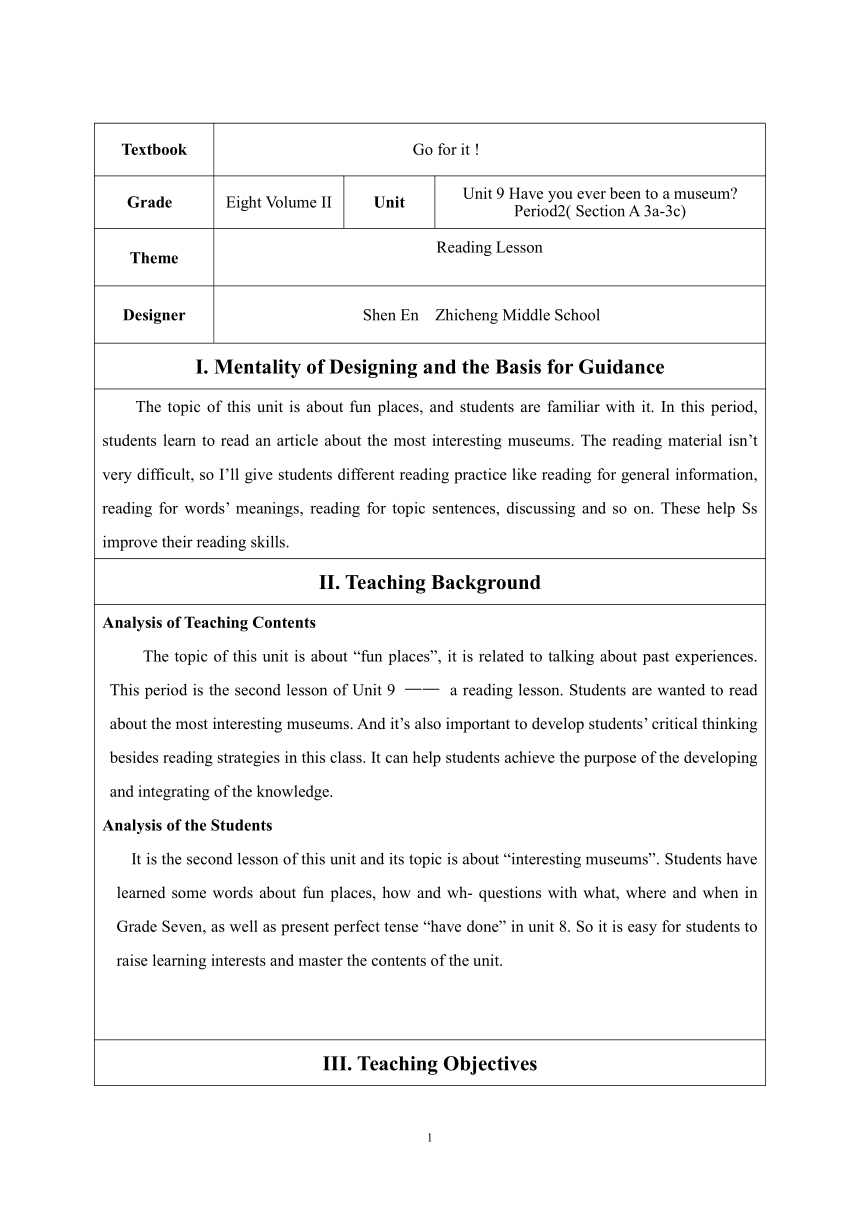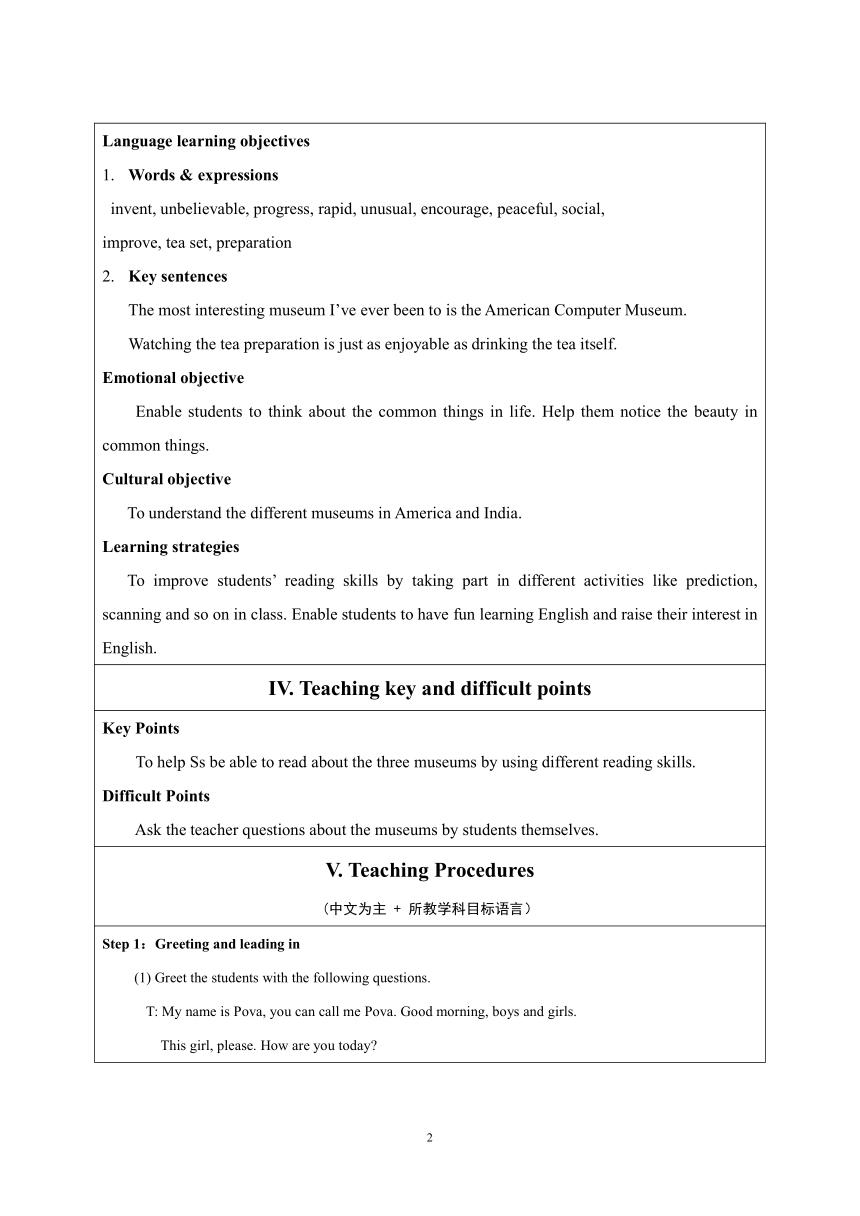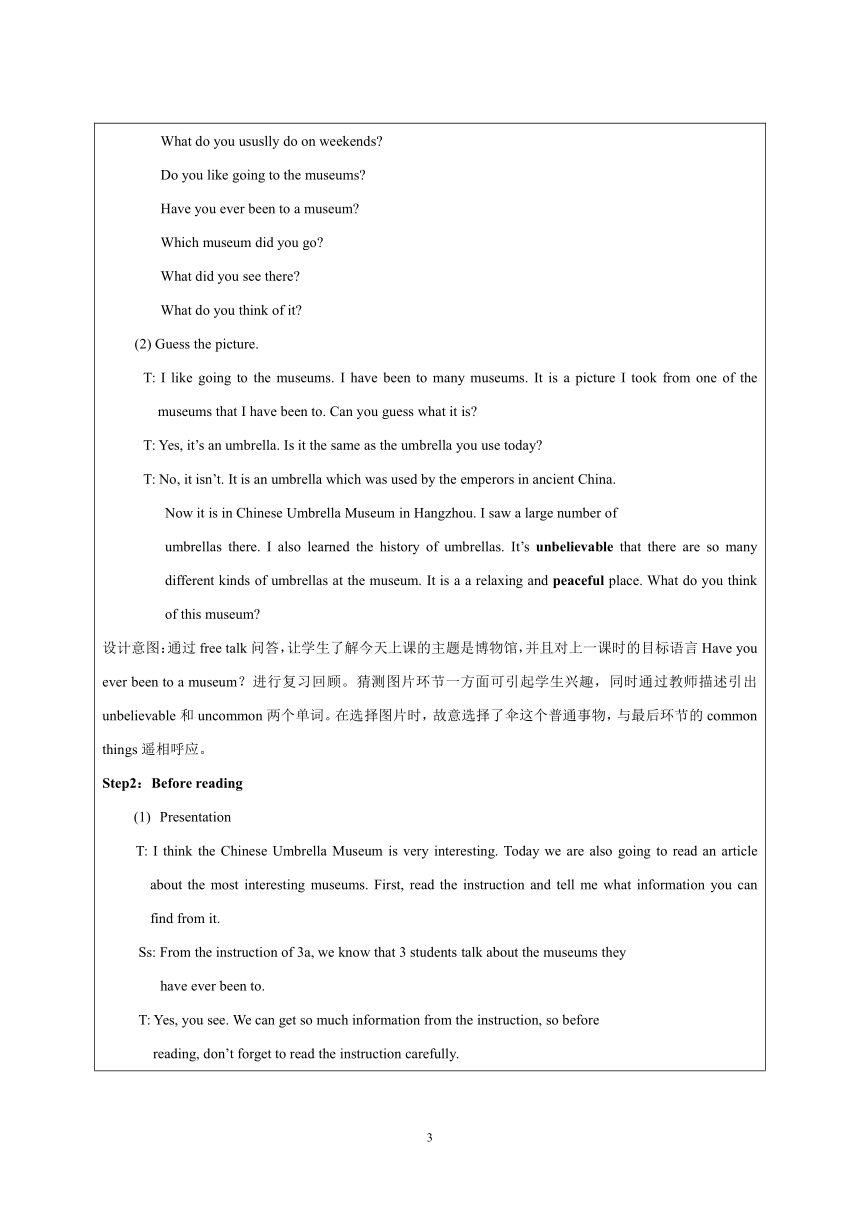Unit 9 Have you ever been to a museum Section A 3a—3c(表格式教案)
文档属性
| 名称 | Unit 9 Have you ever been to a museum Section A 3a—3c(表格式教案) |  | |
| 格式 | doc | ||
| 文件大小 | 84.1KB | ||
| 资源类型 | 教案 | ||
| 版本资源 | 人教新目标(Go for it)版 | ||
| 科目 | 英语 | ||
| 更新时间 | 2022-04-10 09:24:34 | ||
图片预览



文档简介
Textbook Go for it !
Grade Eight Volume II Unit Unit 9 Have you ever been to a museum Period2( Section A 3a-3c)
Theme Reading Lesson
Designer Shen En Zhicheng Middle School
I. Mentality of Designing and the Basis for Guidance
The topic of this unit is about fun places, and students are familiar with it. In this period, students learn to read an article about the most interesting museums. The reading material isn’t very difficult, so I’ll give students different reading practice like reading for general information, reading for words’ meanings, reading for topic sentences, discussing and so on. These help Ss improve their reading skills.
II. Teaching Background
Analysis of Teaching Contents The topic of this unit is about “fun places”, it is related to talking about past experiences. This period is the second lesson of Unit 9 —— a reading lesson. Students are wanted to read about the most interesting museums. And it’s also important to develop students’ critical thinking besides reading strategies in this class. It can help students achieve the purpose of the developing and integrating of the knowledge.Analysis of the Students It is the second lesson of this unit and its topic is about “interesting museums”. Students have learned some words about fun places, how and wh- questions with what, where and when in Grade Seven, as well as present perfect tense “have done” in unit 8. So it is easy for students to raise learning interests and master the contents of the unit.
III. Teaching Objectives
Language learning objectivesWords & expressions invent, unbelievable, progress, rapid, unusual, encourage, peaceful, social,improve, tea set, preparation Key sentences The most interesting museum I’ve ever been to is the American Computer Museum.Watching the tea preparation is just as enjoyable as drinking the tea itself.Emotional objective Enable students to think about the common things in life. Help them notice the beauty in common things.Cultural objective To understand the different museums in America and India.Learning strategiesTo improve students’ reading skills by taking part in different activities like prediction, scanning and so on in class. Enable students to have fun learning English and raise their interest in English.
IV. Teaching key and difficult points
Key Points To help Ss be able to read about the three museums by using different reading skills.Difficult PointsAsk the teacher questions about the museums by students themselves.
V. Teaching Procedures(中文为主 + 所教学科目标语言)
Step 1:Greeting and leading in(1) Greet the students with the following questions.T: My name is Pova, you can call me Pova. Good morning, boys and girls.This girl, please. How are you today What do you ususlly do on weekends Do you like going to the museums Have you ever been to a museum Which museum did you go What did you see there What do you think of it (2) Guess the picture.T: I like going to the museums. I have been to many museums. It is a picture I took from one of the museums that I have been to. Can you guess what it is T: Yes, it’s an umbrella. Is it the same as the umbrella you use today T: No, it isn’t. It is an umbrella which was used by the emperors in ancient China. Now it is in Chinese Umbrella Museum in Hangzhou. I saw a large number of umbrellas there. I also learned the history of umbrellas. It’s unbelievable that there are so many different kinds of umbrellas at the museum. It is a a relaxing and peaceful place. What do you think of this museum 设计意图:通过free talk问答,让学生了解今天上课的主题是博物馆,并且对上一课时的目标语言Have you ever been to a museum?进行复习回顾。猜测图片环节一方面可引起学生兴趣,同时通过教师描述引出unbelievable和uncommon两个单词。在选择图片时,故意选择了伞这个普通事物,与最后环节的common things遥相呼应。Step2:Before readingPresentationT: I think the Chinese Umbrella Museum is very interesting. Today we are also going to read an article about the most interesting museums. First, read the instruction and tell me what information you can find from it.Ss: From the instruction of 3a, we know that 3 students talk about the museums they have ever been to.T: Yes, you see. We can get so much information from the instruction, so before reading, don’t forget to read the instruction carefully.T: Then, look at the pictures and can you guess which three museums the students talk about Ss: Computer museum, toilet museum and tea museum.T: Yes, that’s right. Actually the 3 museums are the American Computer Museum, the International Museum of Toilets and Hangzhou National Tea Museum.设计意图: 通过让学生阅读3a的指令来得出有关文章的信息,因此阅读文章时应先读指令。再通过看图猜测三个博物馆。此环节是读前的文本分析。 (2) DiscussingT:So we know the 3 museums. What do you want to know about their visits to the museums When we want to know something, we can ask questions by using who, when, where, what and how. So please discuss in pairs and tell me what you want to know about their visits to the museums. The questions may include: Who visited the musuems When did they go Where are the museums What did they see and what did they learn there What do they think of the museums 设计意图:学生通过讨论,对于这三位同学博物馆的拜访进行提问。此环节充分从学生角度出发,让学生自己设计问题,充分体现了学生为主体,教师为主导。Step3:While reading(1) Read the article and answer the questions rasied by themselves.设计意图:阅读全文,回答学生自己提出的问题。让学生对全文信息能有大概的了解。(2) Read paragraph 1 and finish the tasks. What surprised Ken most in the American Computer Museum Technology has progressed in such a rapid way! Supporting sentences:What do you think the computers will be able to do in the future 设计意图:精读第一段,通过三个任务层层递进,先问学生最让Ken惊讶的是什么,再找支撑句。最后拿出段中最后一句话问学生的看法,注重拓展学生思维。(3) Read paragraph 2and answer the two questions. 1.What’s the topic sentence of this paragraph 2.What does it encourage government and social groups to do What advice do you have on improving the toilets in our school 设计意图:精读第二段,寻找主题句,继续夯实阅读技巧,最后通过课本句子提问:对于学校厕所你有什么好的意见?引导孩子关心身边事物。(4) Read paragraph 3 and tell True or False. 1. Amy went to the Hangzhou National Tea Museum. 2. Watching the tea preparation is just as enjoyable as drinking the tea itself.T: What does the second sentence mean A. Watching the tea preparation is more enjoyable than drinking the tea.B. Drinking the tea is more enjoyable than watching the tea preparation.C. Watching the tea preparation is very enjoyable, and drinking the tea is also very enjoyable . 设计意图:通过判断正误进一步理解文章内容。同时通过句子辨析,让学生感悟段落中的美词美句,一方面有利于写作提高,另一方面与下一环节衔接。(5) Activity 3a T: The sentences in the article are very beautiful. So are the words in the article. Look at the underlined words in the article, they are all new words. Can you find their meanings 设计意图:完成3c,对新单词进一步理解和强化。Step 4:Reading with the tape.设计意图:跟读课文,再次整体感知阅读材料。Step 5:Conclusion T: After reading the whole passage, let’s make a conclusion. The article is about computer museum, toilet museum and tea museum. Do you have these things at home T: Yes, most of us have computers, toilets and tea at home. So they are common things to us. But the three students think they are interesting, unusual, relaxing and peaceful. Why Ss:Because they learned a lot of uncommon things from the museums. T: That’s right. So museums help us notice the beauty in common things. And that’s one of the amazing parts of museums. 设计意图:对全文进行总结,三位学生对这三样普通的物品有着不普通的看法,因为他们在博物馆学到了很多不同寻常的知识,这就是博物馆的魅力。在生活中,我们也不能忽略普通物品的美。Step 6:Groupwork T: We can learn a lot about common things from the museums. So in free time, we can go to the museums sometimes. And in daily life, we should never fail to notice the beauty in common things. T: Here is a good chance for you to share something about a common thingwhich you are interested in. T: Our school wants to hold an exhibition about a kind of common thing. They want you to help design it. Try to make it interesting. Discuss the followingquestions in group of four.What is it about /What is the most interesting part /What can people see / What can people learn 设计意图:小组讨论,选出一样他们感兴趣的普通物品作为展览物品,并初步设想展览时大家能看到什么,学到什么。此环节结合学生实际,也进一步让学生能关注到身边的小物品。Step 7:HomeworkLevel APolish the writing about your exhibition after class, and report it next class.Read the article and choose your favorite museum to retell.Level BFind more information about one of the museums in the article. Report it next class. 设计意图:分层布置家庭作业,照顾到了学生的不同水平。Level A的作业兼顾到了后进生的水平。Level B的作业可以让学优生提高学习能力和认知能力。
PAGE
7
Grade Eight Volume II Unit Unit 9 Have you ever been to a museum Period2( Section A 3a-3c)
Theme Reading Lesson
Designer Shen En Zhicheng Middle School
I. Mentality of Designing and the Basis for Guidance
The topic of this unit is about fun places, and students are familiar with it. In this period, students learn to read an article about the most interesting museums. The reading material isn’t very difficult, so I’ll give students different reading practice like reading for general information, reading for words’ meanings, reading for topic sentences, discussing and so on. These help Ss improve their reading skills.
II. Teaching Background
Analysis of Teaching Contents The topic of this unit is about “fun places”, it is related to talking about past experiences. This period is the second lesson of Unit 9 —— a reading lesson. Students are wanted to read about the most interesting museums. And it’s also important to develop students’ critical thinking besides reading strategies in this class. It can help students achieve the purpose of the developing and integrating of the knowledge.Analysis of the Students It is the second lesson of this unit and its topic is about “interesting museums”. Students have learned some words about fun places, how and wh- questions with what, where and when in Grade Seven, as well as present perfect tense “have done” in unit 8. So it is easy for students to raise learning interests and master the contents of the unit.
III. Teaching Objectives
Language learning objectivesWords & expressions invent, unbelievable, progress, rapid, unusual, encourage, peaceful, social,improve, tea set, preparation Key sentences The most interesting museum I’ve ever been to is the American Computer Museum.Watching the tea preparation is just as enjoyable as drinking the tea itself.Emotional objective Enable students to think about the common things in life. Help them notice the beauty in common things.Cultural objective To understand the different museums in America and India.Learning strategiesTo improve students’ reading skills by taking part in different activities like prediction, scanning and so on in class. Enable students to have fun learning English and raise their interest in English.
IV. Teaching key and difficult points
Key Points To help Ss be able to read about the three museums by using different reading skills.Difficult PointsAsk the teacher questions about the museums by students themselves.
V. Teaching Procedures(中文为主 + 所教学科目标语言)
Step 1:Greeting and leading in(1) Greet the students with the following questions.T: My name is Pova, you can call me Pova. Good morning, boys and girls.This girl, please. How are you today What do you ususlly do on weekends Do you like going to the museums Have you ever been to a museum Which museum did you go What did you see there What do you think of it (2) Guess the picture.T: I like going to the museums. I have been to many museums. It is a picture I took from one of the museums that I have been to. Can you guess what it is T: Yes, it’s an umbrella. Is it the same as the umbrella you use today T: No, it isn’t. It is an umbrella which was used by the emperors in ancient China. Now it is in Chinese Umbrella Museum in Hangzhou. I saw a large number of umbrellas there. I also learned the history of umbrellas. It’s unbelievable that there are so many different kinds of umbrellas at the museum. It is a a relaxing and peaceful place. What do you think of this museum 设计意图:通过free talk问答,让学生了解今天上课的主题是博物馆,并且对上一课时的目标语言Have you ever been to a museum?进行复习回顾。猜测图片环节一方面可引起学生兴趣,同时通过教师描述引出unbelievable和uncommon两个单词。在选择图片时,故意选择了伞这个普通事物,与最后环节的common things遥相呼应。Step2:Before readingPresentationT: I think the Chinese Umbrella Museum is very interesting. Today we are also going to read an article about the most interesting museums. First, read the instruction and tell me what information you can find from it.Ss: From the instruction of 3a, we know that 3 students talk about the museums they have ever been to.T: Yes, you see. We can get so much information from the instruction, so before reading, don’t forget to read the instruction carefully.T: Then, look at the pictures and can you guess which three museums the students talk about Ss: Computer museum, toilet museum and tea museum.T: Yes, that’s right. Actually the 3 museums are the American Computer Museum, the International Museum of Toilets and Hangzhou National Tea Museum.设计意图: 通过让学生阅读3a的指令来得出有关文章的信息,因此阅读文章时应先读指令。再通过看图猜测三个博物馆。此环节是读前的文本分析。 (2) DiscussingT:So we know the 3 museums. What do you want to know about their visits to the museums When we want to know something, we can ask questions by using who, when, where, what and how. So please discuss in pairs and tell me what you want to know about their visits to the museums. The questions may include: Who visited the musuems When did they go Where are the museums What did they see and what did they learn there What do they think of the museums 设计意图:学生通过讨论,对于这三位同学博物馆的拜访进行提问。此环节充分从学生角度出发,让学生自己设计问题,充分体现了学生为主体,教师为主导。Step3:While reading(1) Read the article and answer the questions rasied by themselves.设计意图:阅读全文,回答学生自己提出的问题。让学生对全文信息能有大概的了解。(2) Read paragraph 1 and finish the tasks. What surprised Ken most in the American Computer Museum Technology has progressed in such a rapid way! Supporting sentences:What do you think the computers will be able to do in the future 设计意图:精读第一段,通过三个任务层层递进,先问学生最让Ken惊讶的是什么,再找支撑句。最后拿出段中最后一句话问学生的看法,注重拓展学生思维。(3) Read paragraph 2and answer the two questions. 1.What’s the topic sentence of this paragraph 2.What does it encourage government and social groups to do What advice do you have on improving the toilets in our school 设计意图:精读第二段,寻找主题句,继续夯实阅读技巧,最后通过课本句子提问:对于学校厕所你有什么好的意见?引导孩子关心身边事物。(4) Read paragraph 3 and tell True or False. 1. Amy went to the Hangzhou National Tea Museum. 2. Watching the tea preparation is just as enjoyable as drinking the tea itself.T: What does the second sentence mean A. Watching the tea preparation is more enjoyable than drinking the tea.B. Drinking the tea is more enjoyable than watching the tea preparation.C. Watching the tea preparation is very enjoyable, and drinking the tea is also very enjoyable . 设计意图:通过判断正误进一步理解文章内容。同时通过句子辨析,让学生感悟段落中的美词美句,一方面有利于写作提高,另一方面与下一环节衔接。(5) Activity 3a T: The sentences in the article are very beautiful. So are the words in the article. Look at the underlined words in the article, they are all new words. Can you find their meanings 设计意图:完成3c,对新单词进一步理解和强化。Step 4:Reading with the tape.设计意图:跟读课文,再次整体感知阅读材料。Step 5:Conclusion T: After reading the whole passage, let’s make a conclusion. The article is about computer museum, toilet museum and tea museum. Do you have these things at home T: Yes, most of us have computers, toilets and tea at home. So they are common things to us. But the three students think they are interesting, unusual, relaxing and peaceful. Why Ss:Because they learned a lot of uncommon things from the museums. T: That’s right. So museums help us notice the beauty in common things. And that’s one of the amazing parts of museums. 设计意图:对全文进行总结,三位学生对这三样普通的物品有着不普通的看法,因为他们在博物馆学到了很多不同寻常的知识,这就是博物馆的魅力。在生活中,我们也不能忽略普通物品的美。Step 6:Groupwork T: We can learn a lot about common things from the museums. So in free time, we can go to the museums sometimes. And in daily life, we should never fail to notice the beauty in common things. T: Here is a good chance for you to share something about a common thingwhich you are interested in. T: Our school wants to hold an exhibition about a kind of common thing. They want you to help design it. Try to make it interesting. Discuss the followingquestions in group of four.What is it about /What is the most interesting part /What can people see / What can people learn 设计意图:小组讨论,选出一样他们感兴趣的普通物品作为展览物品,并初步设想展览时大家能看到什么,学到什么。此环节结合学生实际,也进一步让学生能关注到身边的小物品。Step 7:HomeworkLevel APolish the writing about your exhibition after class, and report it next class.Read the article and choose your favorite museum to retell.Level BFind more information about one of the museums in the article. Report it next class. 设计意图:分层布置家庭作业,照顾到了学生的不同水平。Level A的作业兼顾到了后进生的水平。Level B的作业可以让学优生提高学习能力和认知能力。
PAGE
7
同课章节目录
- Unit 1 What's the matter?
- Section A
- Section B
- Unit 2 I'll help to clean up the city parks.
- Section A
- Section B
- Unit 3 Could you please clean your room?
- Section A
- Section B
- Unit 4 Why don't you talk to your parents?
- Section A
- Section B
- Unit 5 What were you doing when the rainstorm came
- Section A
- Section B
- Review of Units 1-5
- Unit 6 An old man tried to move the mountains.
- Section A
- Section B
- Unit 7 What's the highest mountain in the world?
- Section A
- Section B
- Unit 8 Have you read Treasure Island yet?
- Section A
- Section B
- Unit 9 Have you ever been to a museum?
- Section A
- Section B
- Unit 10 I've had this bike for three years.
- Section A
- Section B
